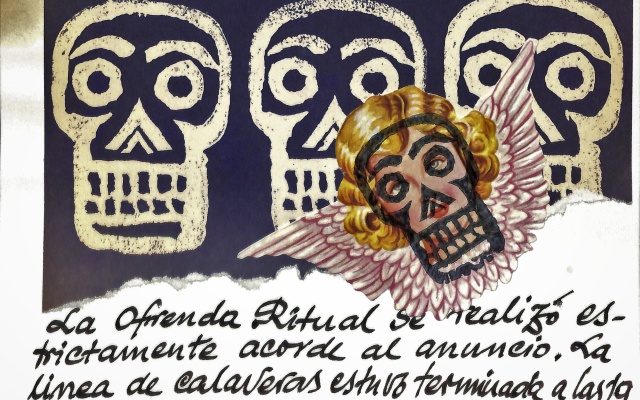1. Axe Work
In 1971, the book Siekierezada by the writer and poet Edward Stachura1 was published. The title is a neologism created by the author. It is both an allusion to Scheherezade, the narrator of One Thousand and One Nights and, in Polish, a pun on the word “siekiera,” or “axe,” thus also referring to the long saga of the monotonous, physical effort of cutting down trees. For the protagonist of this story, this is an alternative to his previous life as a student, poet, and rover. For Stachura, working with an axe stands for a return to nature, finding a sense of existence, and the strengthening of interpersonal bonds. A similar understanding of the significance of this tool also appears in the art of the Polish-Mexican artist Marek Kurycz. The axe, a prop that he first used in 1979 during his performance Hacha Sonora (Sound Axe),2 would in the following years become his trademark. Nevertheless, in Kurtycz’s play, the axe is not only the lumberjack’s tool that serves to tame nature; it is also a weapon that a highwayman uses to induce fear, as did Janosik, the Polish highlander-Robin-Hood figure.
In Sound Axe, considered Kurtycz’s first “ritual action,”3 there appeared the most important features and elements that would recur in his later performances, Artefacts and art-and-facts.4 Kurtycz ritualized his performative actions through the repetition of simple activities, verbal, and sound elements. The spoken sentences, or the songs, often sung in Polish and incomprehensible to a Mexican audience, were interpreted as “prayers.” The artist also employed the device of theatralization. Kurtycz aimed at creating a special bond with the audience, in many performances offering to his viewer a communion, in which he shared his art with them. During his performances, Kurtycz distributed among the audience his drawings and graphic works in the form of leaflets, brochures, maps, photographs, and little artist’s books – whether drawn, printed, made with templates or wax, partially burnt, or photocopied. His relationship with the audience was also built up through a sense of imminent danger. The situations that generated an experience of risk applied mainly, but not exclusively, to the artist himself. Many of his performances took place at height, and involved climbing ladders or platforms, pillars, and masts. The ladder, Kurtycz’s second trademark prop, added a spatial dynamic to his artefacts. The photographs that document his actions employing the ladder and a beam of light are reminiscent of those of circus acrobatics, or Lászlo Moholy-Nagy’s constructivist montages, or El Lissitzky’s gouaches (such as the Kurtycz’s performance Proportions of Snake, Tokyo, 1995). Kurtycz’s originality relied on the fact that, unlike contemporary performance artists, who propose radical experiments with their own body (e.g., the body-based performances of Marina Abramović or Peter Štembera’s body art), he created a situation of risk and imminent danger to the bodies of his viewers.
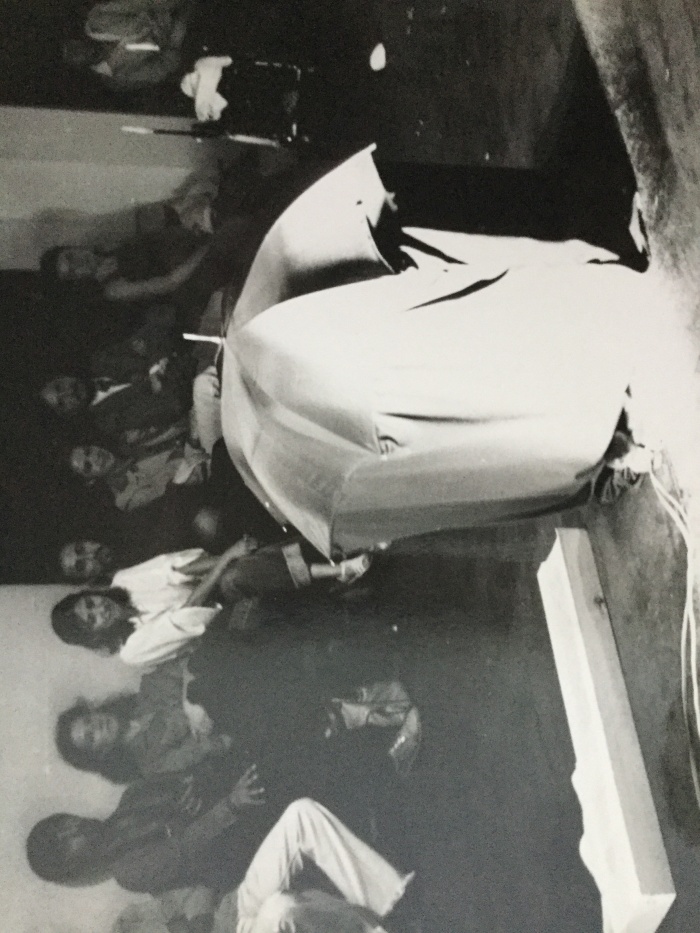
Marcos Kurtycz, Siekiera dźwiękowa / Hacha Sonora, 1979. Archiwum Marcosa Kurtycza, Miasto Meksyk. Dzięki uprzejmości Any Maríi Garcíi Kobeh.
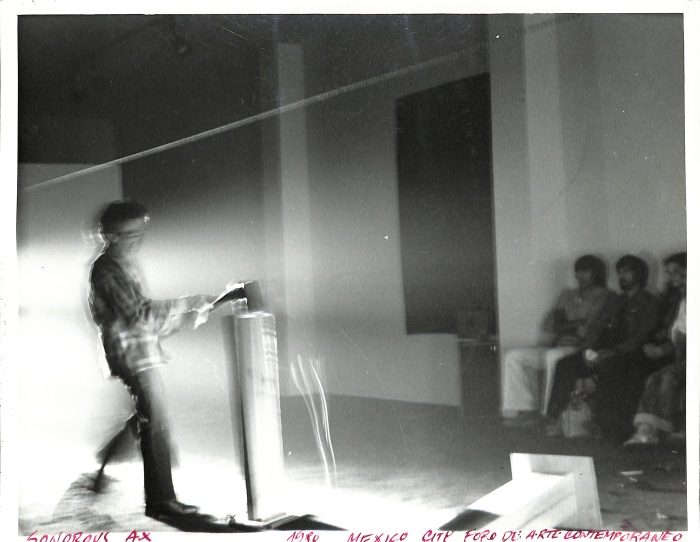
Marcos Kurtycz, Siekiera dźwiękowa / Hacha Sonora, 1979. Archiwum Marcosa Kurtycza, Miasto Meksyk. Dzięki uprzejmości Any Maríi Garcíi Kobeh.
The action Sound Axe proposed participation in a singular, “sharp,” and “penetrating” concert.5 The public in the narrow museum room assisted – at close quarters – in the action of chopping into pieces with an axe the following objects: an apple, an ox’s heart, a mirror, and bread. The performance placed the audience in an uncomfortable situation6 and posed the risk of the artist or members of the audience being hurt by the flying fallout of the chopping. According to Kurtycz, it was particularly the axe that ensured the success of many such actions, especially those conducted in public space, often without the consent of art institutions or local authorities. “The hatchet commands attention, demands respect and protects me,”7 the artist claimed, stressing that “it seems that no technique exists that would make it possible to move a man with an axe from his chosen spot.”8 The axe was the means of introducing tension and turning the artist into a shaman, and in a sense also an aggressor. It was also something that linked Kurtycz to Polish culture. The artist insisted, “It is to my first motherland that I owe the metallurgical element of my work and also its highland texture” [sic].9 As with Stachura, the axe work allows the artist to probe more deeply, to redefine interpersonal relationships and his own attitude to the world. With his axe, Marek Kurtycz elucidated, or perhaps invented Poland for Mexican consumption.
2. Artefact Bombardment
On 1 April 1981, Marcos Kurtycz initiated his Arte-fact Bombing (Artefacto Bombardeo) in the Foksal Gallery, bombarding it with the mail he had prepared earlier. The action consisted of sending for 12 weeks, from different locations in the world, letters, manifestos, graphic works, artist’s books, and artworks to the curator and to one of Foksal’s founders Wiesław Borowski.10 The action targeted the petrification and orthodoxy of the gallery, closed to the art of young artists.11 Kurtycz described the course of the action in his letter manifesto of July 1981. The first letter to Borkowski, written in a friendly and somewhat naïve tone, announced his project for unleashing bombs on a “defenseless temple of art.”12 It was immediately followed by a “complex graphic object,” created by the artist and loaded with an “appropriated dose of Mexican magic.”13 This was the launch of the bombardment proper – which comprised 55 packages and carried on relentlessly from 2 April until July 1981.
Although prior to his final departure for Mexico in 1968, Marcos Kurtycz had participated in a few exhibitions in Poland, until now his work has been practically unknown in his native country. Having graduated as an engineer from the Warsaw Polytechnic, Kurtycz – in parallel to his work in the Institute of Precision Mechanics in Warsaw – embarked on his artistic activity. He took part in group exhibitions, including one at the Hybrydy (1959) Club in Warsaw. In October 1968, he put on an individual show in the Contemporary Gallery in Warsaw. In the accompanying text, Kurtycz postulates a “departure from static image,” proposing an “image of the process” in the form of a series of light “algorithms” (that would appear on the screen, controlled by a machine), as well as monochromatic “digital reliefs” that would be not merely “ornaments” but also a “record […] of the thought process.”14
In Kurtycz’s graphic works and actions elements of Polish culture, folklore, and customs are always present. They include small rituals related to Catholicism (for example, in his action Sound Axe, before chopping up the loaf of bread, the artist made the sign of the cross on it with his axe). Kurtycz conducted a continuing dialogue with Polish theater and art. Interpreting Kurtycz’s performances, critics point to his inspiration by the theatrical concepts of Jerzy Grotowski,15 and his collaboration with Ludwik Margules – a Polish theater director living in Mexico.16 The phallic structure, created in Sound Axe by opening and closing an umbrella, may have been a reference to Kantor and his fascination with umbrellas.17 In his art Kurtycz, like Kantor, drew on his own memories and the traumatic experiences of World War II. During his action Cruz–Cruz (Krzyż–Krzyż) of 1984, the artist presented his family photo album. Prior to the performance, the pages of the album showing Kurtycz’s family had been soaked with a chemical. During the performance, the artist slowly destroyed the book using his lit cigarette – in a symbolic gesture that referred to the torture and suffering that his family had experienced during the war.18
Kurtycz’s early interest in the relationship between art and cybernetics, and his street performance La Rueda (Wheel) in Mexico City in 1976 bring the artist closer to Krzysztof Wodiczka. The action Wheel consisted of rolling a colored disc with a diameter of 1.2 m through urban space; it was dedicated to Isaac Newton who in 1667 had split light using a prism. Kurtycz’s performance with the huge replica of Newton’s device – just like Wodiczko’s journey through the streets of Warsaw using his Vehicle (1973) – proposes a redefinition of the experience of urban reality. Like Wodiczko, who conducted a critical dialogue with the idea of avant-garde art and Gierek’s propaganda of progress, in this action Kurtycz questioned the relationship between art and science, and municipal reality versus the theory of perception, drawing on the aesthetics of a constructivist project.
There are certainly links between Kurtycz’s ritualistic artifacts and actions and the “masses” of Jerzy Bereś. Both artists created ruralist, metaphorical actions, often carried out in plein air or urban space, often using objects that they had made themselves. Both Kurtycz and Bereś had evolved their repertory of simple, recurrent gestures inspired by folklore and religious rituals. Both combined happening and performance art with other areas of the visual arts, using their own artworks: Bereś – sculpture, Kurtycz – graphics. Both employed fire. Their actions referred directly to the ritual of sacrifice. Nevertheless, Kurtycz, only a few years younger than Bereś, was closer to the younger generation of performance artists in his approach to his body and his constant testing of the limits of his endurance. That kind of experimentation with his own physicality was absent from the art of Bereś.
The Artefact Bombardment of the Foksal Gallery, as well as his later mail-shot “sniper action” that targeted other institutions and people in the art world were Kurtycz’s original contribution to mail art. In South America, the idea of bomb-making appears in the context of mail art and has been related to using networks of artistic contacts and in particular to propagate open criticism of contemporary society. In this manner, the Uruguayan artist Clemente Padín distributed his publication Happy Bicentennial – a manual explaining how to make a DIY bomb at home, reminiscent of underground instruction brochures for Latin America rebel fighters about actual weapons.19 The brochure prepared by Padín commented critically on the exploitation of Latin America by Western capitalism. Similarly, the Venezuelan artist Dámaso Ogaz referred to mail art activity as a “home-made bomb.”20 Kurtycz and his contemporary artists from South America share this symbolic drawing on the practices of revolutionary guerrillas. Nevertheless, nobody has attempted to venture beyond the symbolic in this struggle and resistance; Kurtycz’s actions also took place in the area of symbol and metaphor, although the bombardment action was real. Kurtycz’s “blitz” was a mischievous way of reversing the artist versus gallery relationship. Turning the act of bestowing art works as a gift into inflicting pain, Kurtycz put himself in the shoes of an oppressive client. This original use of mail art is reminiscent of “escrache” – acts of condemning abuses and corruption committed by politicians, the military, and high-rank apparatchiks. Often organized in the form of demonstrations close to the place of residence of the individuals concerned, escraches have been widespread throughout South America since the 1990s, since the removal from power of local civilian and military dictatorships. Similarly, with his bombardment, Kurtycz has pinpointed the problem of the Polish independent art scene. Towards the end of his open letter, Kurtycz asks the public to join in the preparation and throwing of the bombs, because “in spite of the sturdy effort, the gallery remains almost intact, still standing there as before.”21 Kurtycz’s action ended in a fiasco: Foksal ignored the bombardment. In the catalog that summed up the three decades of the gallery’s activity, Kurtycz was not mentioned among the artists that had collaborated with the institution.22 Nor has the artist been mentioned in contemporary analysis of the role of the Foksal Gallery in an international context. The Artefact Bombardment expressed Kurtycz’s frustration, which arose out of his lack of connection with the Polish art scene, and his unfulfilled desire to participate in the creation of Polish culture. Just as the axe had been the prop that had helped Kurtycz build his relations with Mexican audiences, the mail bomb – characteristic of South American mail art – helped him to establish contact with the Warsaw artistic community. The “Mexican” bomb hit the Polish art system and, just like the sinister axe blade, was an attempt to threaten, and as a result – to make an impact.
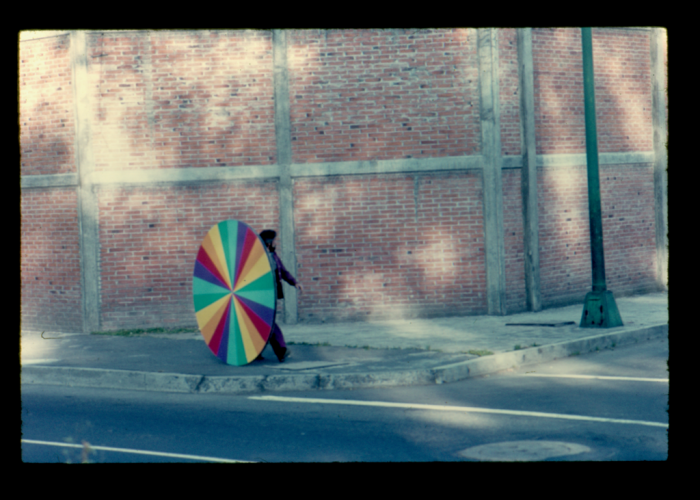
Marcos Kurtycz, Koło / La Rueda, 1976. Archiwum Marcosa Kurtycza, Miasto Meksyk. Dzięki uprzejmości Any Maríi Garcíi Kobeh.
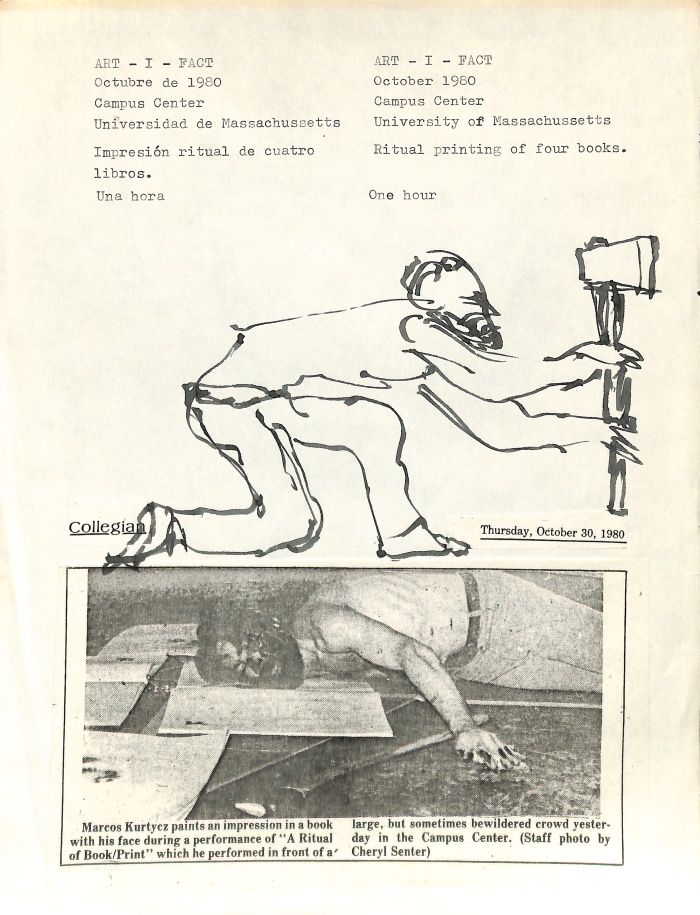
Marcos Kurtycz, Art - I – Fact, 1980. Archiwum Marcosa Kurtycza, Miasto Meksyk. Dzięki uprzejmości Any Maríi Garcíi Kobeh.
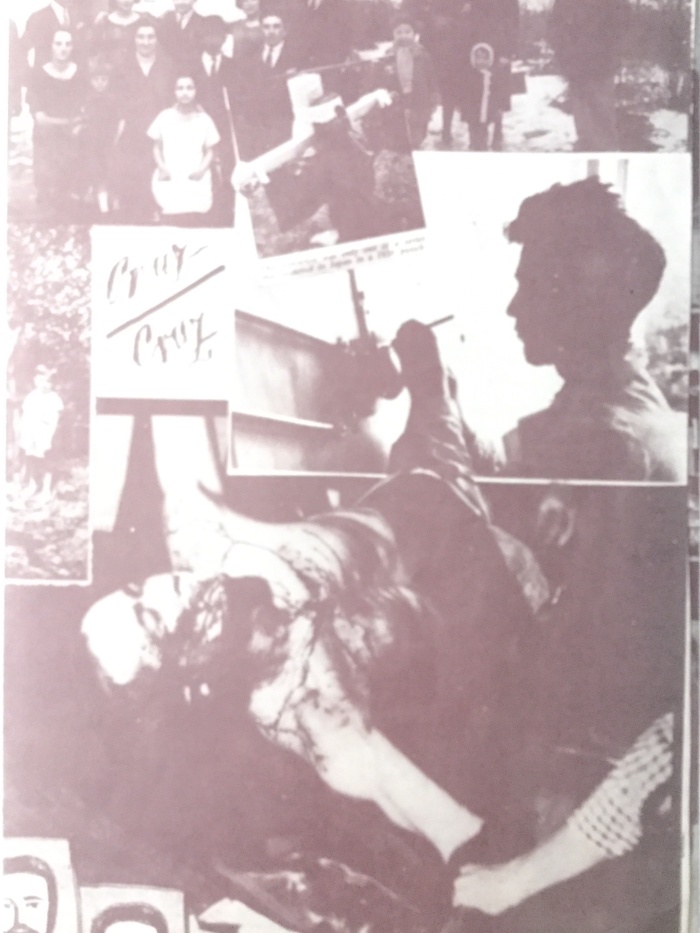
Marcos Kurtycz, Krzyż-Krzyż / Cruz-Cruz, 1984. Archiwum Marcosa Kurtycza, Miasto Meksyk. Dzięki uprzejmości Any Maríi Garcíi Kobeh.
3. Transborders
The curator and theoretician Gerardo Mosquera, when analyzing, in 2000 the art of Ana Mendieta (1948–1985) – a Cuban resident in the USA – stressed her specific position as an artist and immigrant, stuck between the two Americas: North and South (Latin, but also the pre-Hispanic). Analyzing the manner in which she drew on the local folklore and tradition of pre- and non-European art, Mosquera noticed a certain recurrence: “Aboriginal and African elements were often used in the art of Latin America as a passport to express one’s originality when faced with the Western world, perceived in the categories of both affiliation and opposition.”23 Mosquera stressed the “importance of the critical change carried out by artists, who, relying on non-Western systems of thought, created very complex, multi-thread discursive works, which in some cases established the active participation of Afro- and Indian-American cultures in the creation of an ‘international’ modern art.”24 Exactly the same things that Mosquera had observed in the performances of the Cuban artist could be said to apply to Kurtycz’s art. According to Mosquera, Mendieta’s actions showed ‘realistic’ scenes of oppression25 and were sui generis “compensative rituals of her personal schism,”26 in order to finally allow the artist to “employ herself as a metaphor.”27
Just like Mendieta, Kurtycz was an artist who reacted to the crisis of modern art and the liquefaction of identity.”28 Thanks to his experience of emigration, Kurtycz, like Mendieta, was an artist who anticipated the crisis of (national) affiliation. He also reacted critically to the processes of cultural homogenization within the globalization of the art system and to phenomena defined in the context of Western culture as “postmodernism.” In the late 1980s, he began to develop the concept of SOFTWARS. The artist used this neologism – coined from the words “soft” and “war,” which also immediately brought to mind the word “software” – to define a symbolic velvet revolution – a “soft” struggle for a re-evaluation of the concept of art. Kurtycz used English, the language of the globalized art scene as his “language of war.”29 According to Kurtycz himself, his SOFTWARS strategy, in which he also included Bombardments, had been inspired by the texts of Stefan Morawski – a Warsaw philosopher and historian of aesthetics, with whom the artist was friends.
In 1988, analyzing Kurtycz’s unclassified “creative approach,” Morawski categorically opposed Kurtycz’s art as “postmodern.”30 Moreover, the artists that he deemed “postmodern” differed from Kurtycz in their approach to the question of the past. Morawski thought that the “pseudo art” created by postmodernists lacked the “spiritual splendor emanating from Kurtycz’s anti-art.”31 According to Morawski:
“Kurtycz is forever a warrior, questioning the status quo and breaching all the rules. If Kurtycz were a priest, he would be for the theology of liberation; if he were a philosopher, he would seek the haven of existence or join Feyerabend in his neo-dadaist epistemology; if he were a scientist, he would provide new mini-answers to old questions.”32
The term “beyond-art” that Morawski uses to describe Kurtycz’s33 works can be understood above all as an attempt to locate his artistic output outside of the Western system of art.
Kurtycz operates on two fronts and keeps changing his strategy. In Mexico, he is a crude Polish lumberjack that hacks an ox’s heart into pieces. In Poland he presents himself as a Latin American terrorist, bombarding his target with magical objects, and also as a Mexican artist, who signs his works “Kurtix” or “MareKurtix.” Significantly, Kurtycz initiated the Bombardment soon after becoming a citizen of Mexico in 1980. Kurtycz used the “non-Western” elements not only, as Mosquera had pointed out, to emphasize his originality,34 but also to express what in 1980 Ana Mendieta defined as a “personal desire to continue being ‘different.’”35 While the strategy described by the Cuban theoretician concerned Kurtycz mainly using “exoticity” for the process of constructing his own international career and solidifying his position in the so-called “West,” in this, he was again inconsistent. His strategy of inventing himself as the Other – “barbaric,” “primitive,” and “brutal” – in both cases applies to contexts marginalized by canonical narratives about art. This experience of a simultaneous belonging to and opposition against Western culture – which, before Mosquera, the Argentinian philosopher Rodolfo Kusch had already in the 1950s described as “mestizo consciousness”36 – in the case of Kurtycz is related to two countries, both perceived as “barbarian” and “peripheral” or “quasi-peripheral” in the contemporary global system. Kurtycz’s identity – doubly peripheral or doubly marginal – was the starting point for his works on “border thinking.” As Walter Mignolo notes, this is a reaction to the rhetoric of Eurocentric contemporaneity.37 According to Mignolo, border thinking stems directly from the actual experience of living “on the border,”38 combined with the direct or symbolic state of “being” an immigrant, whose culture, views, and value system do not fit in with the norms of the Western contemporaneity project. It is precisely the awareness of being outside of this project that, according to Mignolo, makes it possible to criticize it.
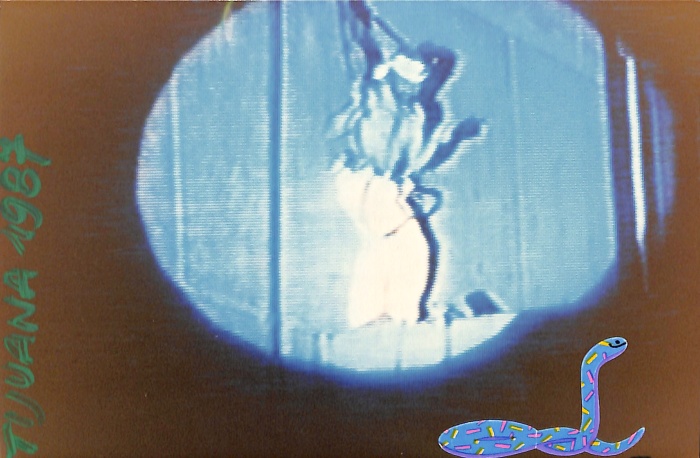
Marcos Kurtycz, Człowiek na linii - Transborder (Tryptyk granicy) / Hombre en la línea - Transborder (Tríptico de la frontera), 1985. Archiwum Marcosa Kurtycza, Miasto Meksyk. Dzięki uprzejmości Any Maríi Garcíi Kobeh.
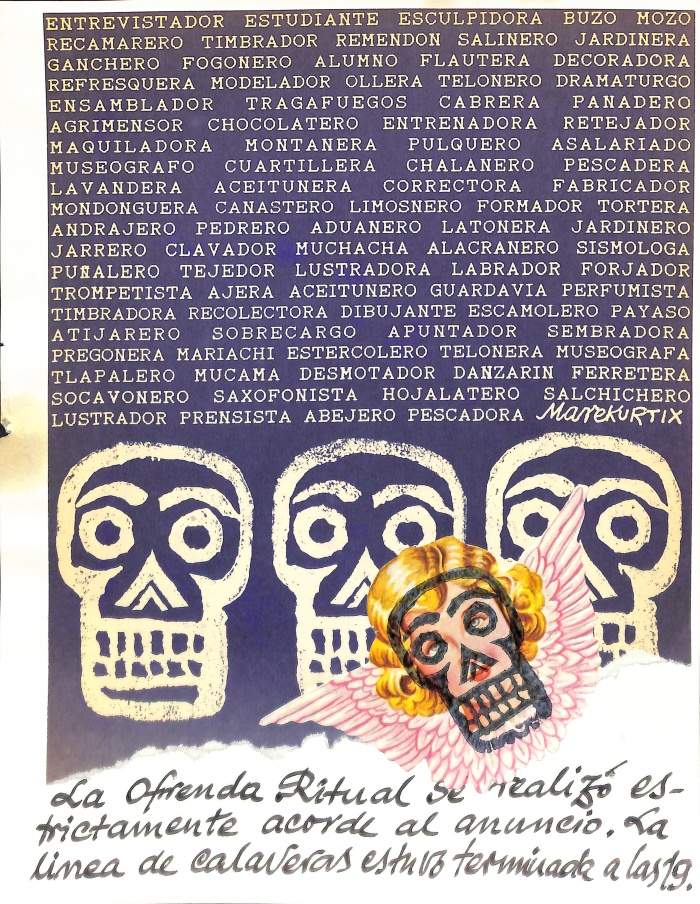
Marcos Kurtycz, Tysiąc czaszek / Mil de calaveras , 1987. Archiwum Marcosa Kurtycza, Miasto Meksyk. Dzięki uprzejmości Any Maríi Garcíi Kobeh.
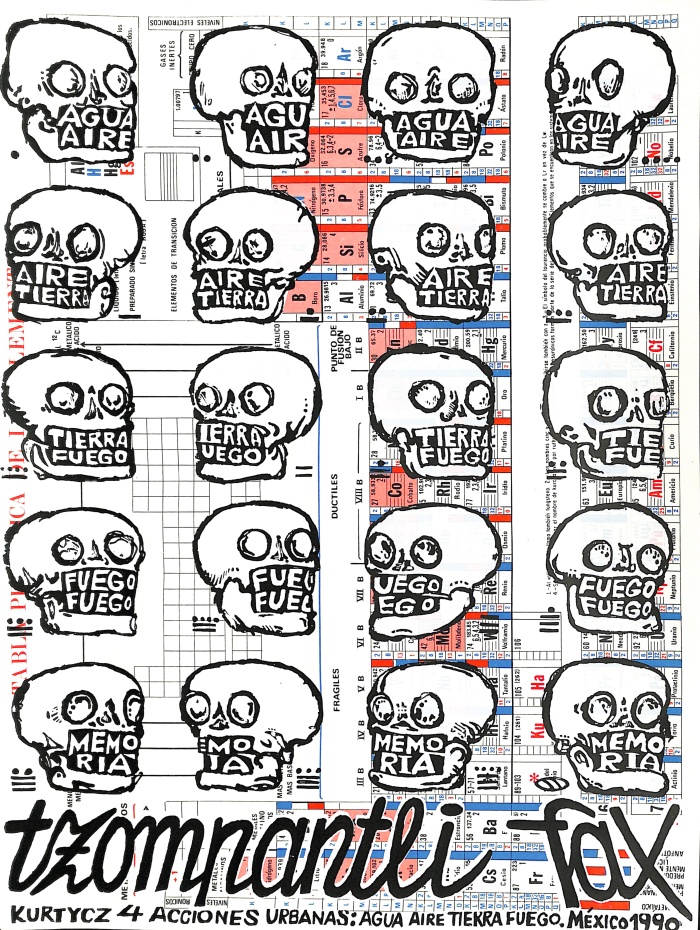
Marcos Kurtycz, Tzompantli Fax. 4 akcje miejskie: woda, powietrze, ziemia, ogień / Tzompantli Fax. 4 acciones urbanas: agua, aire, tierra, fuego, 1990. Archiwum Marcosa Kurtycza, Miasto Meksyk. Dzięki uprzejmości Any Maríi Garcíi Kobeh.
Kurtycz seems to perceive the folk traditions and popular culture of both Poland and Mexico as a remedy for the petrification of the art system that these countries had been developing in accordance with the Western model. Kurtycz placed the “artifact” – that according to him should possess “gut sincerity” (la sinceridad visceral)39 – in opposition to art that he termed “commercial.”40 In his actions, which postulate a symbolic return to the local traditions, Kurtycz acts from the position of “border thinking.” In 1985, Kurtycz carried out his performance Hombre en la línea (Man on the Line), the second in the series Transborder (Tríptico de la frontera). It consisted of the artist walking along a long, concrete beam suspended between the two buildings of the Cultural Center in Tijuana. From the bag attached to the artist’s body spilt cards showing the figure of an immigrant with a picture of Mary, Mother of God, from Guadalupe. Man on the Line was one of Kurtycz’s artifacts, during which, to use Mosquera’s words, he used “himself as a metaphor.”41 This was not, as it may have appeared at first glance, an interpretation of the rite of passage, but rather an attempt to visualize the artist’s own position vis-à-vis the two cultures that mattered to him: Polish and Mexican. This was an attempt at self-definition, through “positioning” himself on the border. The Polish artist Marek Kurtycz looked at Polish culture from the position of a Mexican. The Mexican artist Marcos Kurtix approached Mexican culture distancing himself as a Pole. What had caused the struggle were the ossified conventions of the art world – its commercialization and occidentalization. The state of “soft war” announced by the artist allowed the use of force and did not permit a moment’s rest.
Marek Kurtycz / Marcos Kurtix was born in 1934 in Pielgrzymowice. He studied at the Warsaw Polytechnic, where in 1957 he graduated as an engineer. In 1968, he settled permanently in Mexico. His works have been exhibited in Mexico, the USA, Canada, Japan, and Europe. Kurtycz’s retrospective exhibitions include those at the Museo de Arte Carrillo Gil in Mexico (1999 / 2000), and MoMA PS1 in New York (2002). In September 2018, there will be a comprehensive retrospective exhibition titled Marcos Kurtycz. Contra el estado de guerra, un arte de acción total (Marcos Kurtycz: Against the State of War, an Art of Total Action), prepared by Francisco Reyes Palma at the Amparo Museum in Puebla, Mexico. A monograph on the artist is due in the near future, titled Marcos Kurtycz: Corporeality Unbound / Marcos Kurtycz: Corporalidad al límite by Ana María García Kobeh and Mary Polgovsky Ezcurra (Somosfauna, Mexico City, 2018). Information on Kurtycz’s art can be found at: http://www.marcoskurtycz.com.mx
BIO
Dr. Katarzyna Cytlak is a Polish art historian based in Buenos Aires whose research focuses on art in Central Europe and Latin America in the second half of the 20th century. Her main interests are conceptual art as well as radical and utopian architecture. She defended her PhD thesis at the University Paris 1 Panthéon-Sorbonne: The Grey Utopias: Architectural Projects in Central Europe in the 1970s. She has published her texts in the reviews Umění/Art, Eadem Utraque Europa, Telón de Fondo, Third Text, RIHA Journal, amongst other titles. She is currently working at the CEMECH – Centre for Studies of Chinese and Slavic Worlds at the University of San Martín, Argentina. Her areas of research include East European and Latin American conceptual art, decolonial theory and art history as well as criticism in the post-communist countries. She is a member of the Polish Institute of World Art Studies (Polski Instytut Studiów nad Sztuką Świata).
* Cover photo: Marcos Kurtycz, Mil de calaveras , 1987. Archives of Marcos Kurtycz, Mexico City. Courtesy of Ana María García Kobeh.
[1] Edward Stachura, Siekierezada albo Zima leśnych ludzi, Czytelnik, Warsaw 1971.
[2] Hacha Sonora, Suceso contemporáneo en el salón. (Sound Axe: Contemporary Salon Event), 1979. Action in the upstairs gallery of the Forum of Contemporary Art (Foro de Arte Contemporáneo), Mexico City. In collaboration with Ana María García Kobeh.
[3] The term used by Patricia Sloane in Memoria, 1999. The text was written for the purposes of the exhibition Marcos Kurtycz. Memoria, Museo de Arte Carrillo Gil, Mexico City, 17 November 1999 – 13 February 2000.
[4] The terms used by the artist himself to define his performances.
[5] The term used by Ana María García Kobeh, who assisted Kurtycz during the action. Information from the author’s interview with Ana María García Kobeh, Mexico, 15 March 2017.
[6] Ibid. Ana María García Kobeh mentions that some participants of the action tended to exclaim in fear.
[7] Felipe Agudelo Tenorio, Entrevista con Marcos Kurtycz, in: Tribu (Le Livre Immédiat de Tepoztlán), no. 9, 1985, 4 unnumbered pages. All the translations from Spanish and English by the author of the article.
[8] Ibid. Kurtycz’s self-analysis of performative actions: María Dulce de Alvarado Chaparro, Performance en México 28 testimonios, 1995–2000, Diecisiete, Mexico 2015.
[9] Marek Kurtycz, Soy Kurtycz, in: Marcos Kurtycz. Memoria, Museo de Arte Carrillo Gil, Meksyk, 17 XI 1999 – 13 II 2000, Galeria Sloane-Racotta / Museo de Arte Carrillo Gil, Mexico City 2000, exhibition catalog published on a CD.
[10] The artist asked for the assistance of his family and friends, who from all corners of the world – and often from Poland – sent him the parcels previously prepared by him. According to the author’s telephone interview with Paweł Anaszkiewicz, Mexico, 14 March 2017 and interview with Stanisław Moskała, Mexico, 17 March 2017.
[11] Marek Kurtycz, Bombardowanie Foksalu (arte-fakt). Ogólna informacja o projekcie i zaproszenie do współpracy, Mexico August 1981. Translation of the letter: Marcos Kurtycz, Carta Abierta. Asunto: Artefacto Bombardeo. Información general e invitación, in: ed. Mauricio Marcin, Artecorreo, Museo de la Ciudad de México / RM Verlag, Mexico City / Barcelona 2013, p. 145.
[12] Ibid.
[13] Ibid.
[14] Jan Marek Kurtycz, O pokazie algorytmów plastycznych, text published as a folder for the exhibition Jan Marek Kurtycz. Algorytmy plastyczne, Galeria Współczesna, Warsaw October 1968.
[15] Mara Polgovsky Ezcurra, Shaman, Thespian, Saboteur: Marcos Kurtycz and the Ritual Poetics of Institutional Profanation, in: Sophie Halart and Mara Polgovsky Ezcurra, Sabotage Art. Politics and Iconoclasm in Contemporary Latin America, I. B. Tauris & Co. Ltd, London, New York, 2016, pp. 35–57.
[16] According to the authors’ interview with Ana María García Kobeh, Mexico, 15 March 2017.
[17] For example, Tadeusz Kantor Parasole, in: Tadeusz Kantor, Komentarze intymne, 1986–88, manuscript, Cricoteka Archive, Krakow, pp. 35–36.
[18] Born into a Polish-Jewish family, Kurtycz had lost almost all his relatives during World War II.
[19] Clemente Padín, Happy Bicentennial, Daylight Press, Amsterdam, 1976.
[20] Virginia Vidal, Dámaso Ogaz y su culto del arte total, El Nacional de Caracas, 13 May 2002, one unnumbered page.
[21] Marek Kurtycz, Bombardowanie Foksalu…, op. cit.
[22] Galeria Foksal 1966-1994, Foksal Gallery, Warsaw 1994, p. 157.
[23] Gerardo Mosquera, Ana Mendieta. Art, Religion and Cultural Difference / Arte, religión y diferencia cultural, „Artlies,” no. 28, autumn 2000, p. 22.
[24] Ibid, pp. 22–23.
[25] Ibid, p. 23.
[26] Ibid.
[27] Ibid, p. 24.
[28] Zygmunt Bauman, Liquid Modernity, Polity Press, Cambridge, 2000. Polish edition: Płynna nowoczesność, Wydawnictwo Literackie, Krakow 2006.
[29] Since the mid-80s, Kurtycz has titled his artefacts almost exclusively in English.
[30] Stefan Morawski, SOFTWARE #5. From STEFAN MORAWSKI, Warsaw April 1988, Meksyk, V 1988, in: Marcos Kurtycz, SOFTWARE Number Five. Stefan Morawski, NYPR89EKT SOFTWARS, SOFTWARS’ STANDBY EDITIONS, New York, 1988, 5 unnumbered pages.
[31] Ibid.
[32] Ibid.
[33] Ibid.
[34] Gerardo Mosquera, Ana Mendieta…, op. cit.., p. 24.
[35] Ana Mendieta, Ino.oduction, in: Dialectics of Isolation. An Exhibition of Third World Women Artists of the United States, exhibition catalog, A.I.R. Gallery, New York, 2–20 September 1980, one unnumbered page.
[36] The term proposed by Kusch in order to describe the singular experience of closeness and simultaneous distance, in Latin America associated with Europe, its history, culture, and value system. Rodolfo Kusch, La seducción de la barbarie. Análisis herético de un continente mestizo, Editorial Raigal, Buenos Aires, 1953.
[37] Walter D. Mignolo and Madina V. Tlostanova, Theorizing from the Borders: Shifting to Geo- and Body-Politics of Knowledge, in: European Journal of Social Theory, vol. 9, no. 2 2006, pp. 205–221.
[38] Ibid.
[39] Marcos Kurtycz, Soy Kurtycz, op. cit.
[40] Ibid.
[41] Gerardo Mosquera, Ana Mendieta…, op. cit.., p. 24.



